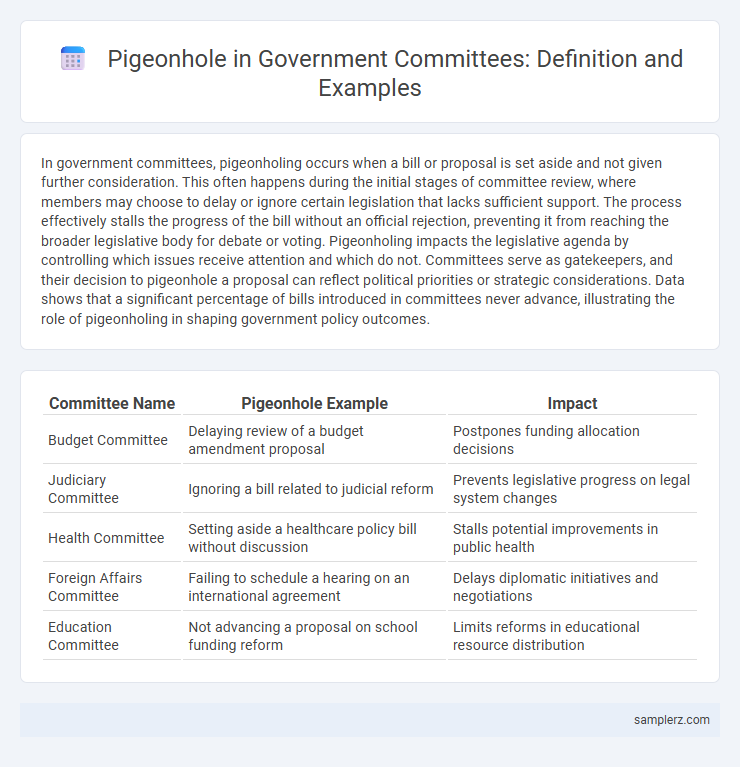In government committees, pigeonholing occurs when a bill or proposal is set aside and not given further consideration. This often happens during the initial stages of committee review, where members may choose to delay or ignore certain legislation that lacks sufficient support. The process effectively stalls the progress of the bill without an official rejection, preventing it from reaching the broader legislative body for debate or voting. Pigeonholing impacts the legislative agenda by controlling which issues receive attention and which do not. Committees serve as gatekeepers, and their decision to pigeonhole a proposal can reflect political priorities or strategic considerations. Data shows that a significant percentage of bills introduced in committees never advance, illustrating the role of pigeonholing in shaping government policy outcomes.
Table of Comparison
| Committee Name | Pigeonhole Example | Impact |
|---|---|---|
| Budget Committee | Delaying review of a budget amendment proposal | Postpones funding allocation decisions |
| Judiciary Committee | Ignoring a bill related to judicial reform | Prevents legislative progress on legal system changes |
| Health Committee | Setting aside a healthcare policy bill without discussion | Stalls potential improvements in public health |
| Foreign Affairs Committee | Failing to schedule a hearing on an international agreement | Delays diplomatic initiatives and negotiations |
| Education Committee | Not advancing a proposal on school funding reform | Limits reforms in educational resource distribution |
Understanding Pigeonholing in Government Committees
Pigeonholing in government committees occurs when a proposed bill is deliberately set aside or ignored, preventing it from advancing to a debate or vote. This tactic effectively stalls legislation by assigning it to a committee where it receives little to no attention, often halting policy changes. Understanding this process reveals how legislative agendas can be controlled and bills blocked without formal rejection.
Classic Cases of Pigeonholing Bills
Classic cases of pigeonholing bills in government committees include the 1968 Gun Control Act, which stalled in the House Judiciary Committee for months before passing. Another notable example is the Family and Medical Leave Act of 1993, initially delayed in the House Committee on Education and Labor. These incidents highlight how committees can effectively block legislation by withholding it from the floor calendar.
Mechanisms Used to Pigeonhole Proposals
Committees often use scheduling delays, refusal to place proposals on the agenda, and excessive subcommittee referrals as mechanisms to pigeonhole bills and prevent their further consideration. These procedural tactics effectively stall legislation by limiting debate opportunities and restricting the flow of proposals to the full legislative body. The strategic control over committee calendars and referral processes ensures that unwanted bills remain inactive and fail to advance.
Effects of Pigeonholing on Legislation
Pigeonholing in government committees leads to significant delays or complete stagnation of proposed legislation by effectively sidelining bills without a full review or vote. This practice reduces legislative efficiency and prevents potential policies from addressing critical public issues, contributing to voter frustration and diminished trust in governmental processes. The overall impact includes weakened democratic responsiveness and missed opportunities for progressive reforms.
Famous Committee Pigeonholing Incidents
The Senate Judiciary Committee's prolonged delay in advancing Supreme Court nominees serves as a prominent example of pigeonholing in government committees, often reflecting intense political strategy rather than procedural necessity. In 2016, the Senate's refusal to hold hearings for Merrick Garland, President Obama's nominee, underscored how pigeonholing can effectively block significant appointments. This practice, by stalling critical legislation or nominations, reveals the powerful role committee chairs and majority parties play in shaping government outcomes.
How Pigeonholing Influences Policy Outcomes
Pigeonholing in government committees occurs when a proposed bill is deliberately set aside or ignored, preventing it from progressing in the legislative process. This tactic shapes policy outcomes by stalling potentially controversial or unpopular legislation, effectively controlling the legislative agenda and limiting debate. The strategic use of pigeonholing can protect existing interests and maintain the status quo by obstructing reforms before they reach the floor for a vote.
Reasons Committees Choose to Pigeonhole
Committees often choose to pigeonhole bills to manage limited time and prioritize legislation deemed less urgent or controversial. This process allows members to avoid contentious debates or divert attention from politically sensitive issues. By sidelining certain proposals, committees maintain focus on higher-priority agendas and streamline legislative workflow.
Pigeonholing vs. Other Legislative Delays
Pigeonholing in government committees occurs when a bill is intentionally set aside without debate or vote, effectively stalling its progress indefinitely. Unlike other legislative delays such as extended committee reviews or scheduling conflicts, pigeonholing prevents any formal consideration, halting the bill at an early stage. This tactic serves as a powerful tool to quietly kill legislation without public scrutiny or procedural hurdles.
Strategies to Prevent Pigeonholing in Committees
Committees can prevent pigeonholing by implementing transparent agenda-setting processes that involve diverse member input and rotating chairmanship to distribute influence evenly. Establishing clear procedural rules for debate limits and timelines ensures that all proposals receive adequate consideration, reducing the risk of intentional delay or neglect. Regular performance evaluations and accountability mechanisms promote active participation and discourage members from sidelining critical issues.
Reform Efforts Targeting Committee Pigeonholing
Reform efforts targeting committee pigeonholing in government aim to increase transparency and accountability by implementing stricter deadlines for bill reviews and ensuring bipartisan representation within committees. Legislative bodies have introduced measures such as automatic discharge petitions that allow stalled bills to bypass pigeonholed status and reach the floor for debate. These strategies seek to prevent indefinite delays and promote a more efficient legislative process.

example of pigeonhole in committee Infographic
 samplerz.com
samplerz.com